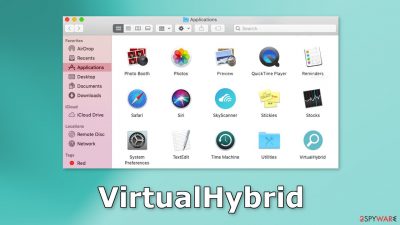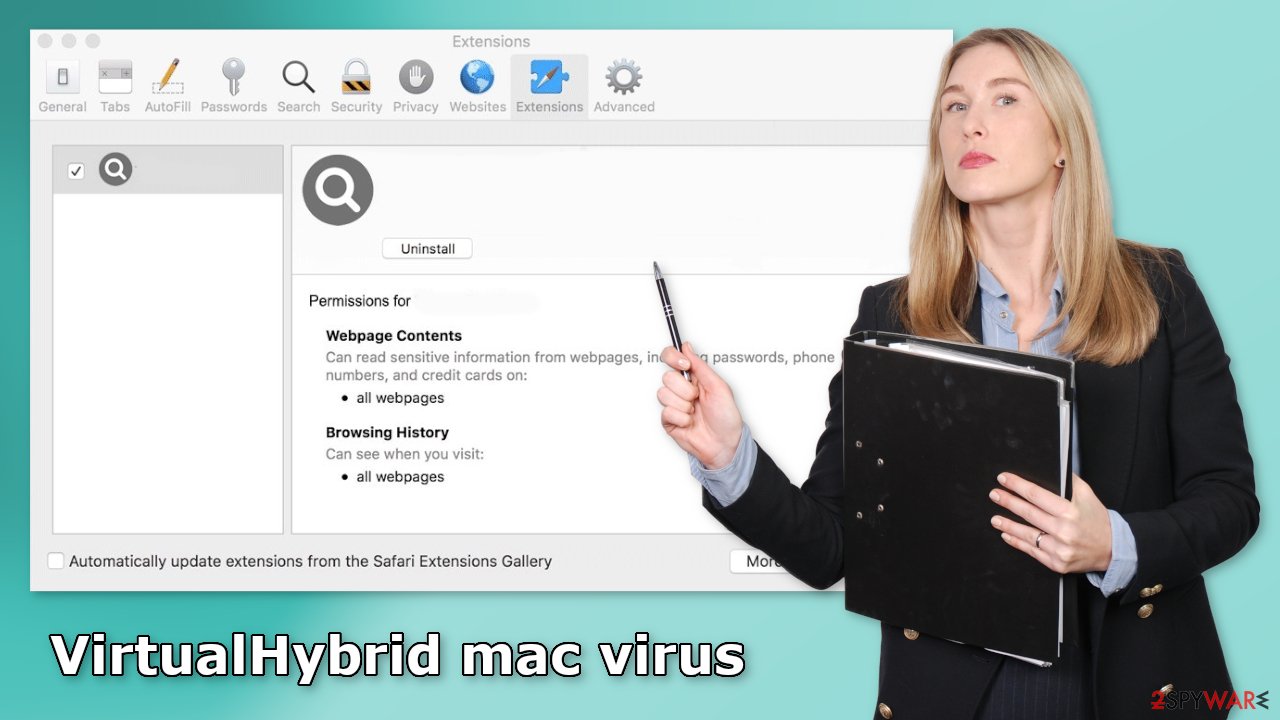VirtualHybrid mac virus (Free Instructions)
VirtualHybrid mac virus Removal Guide
What is VirtualHybrid mac virus?
VirtualHybrid mac virus can make your machine unusable by spamming you with ads

VirtualHybrid mac virus belongs to the Adload malware family. It has both adware[1] and hijacking capabilities. It can cause an increased amount of commercial content, like pop-ups, banners, and redirects. It can also change the main browser settings, like the homepage, new tab address, and search engine.
However, mac adware is much more aggressive than adware designed to infect Windows machines. It can also automatically install PUPs (potentially unwanted programs), and even malware without the users' knowledge. Besides, the links embedded in the ads may lead to dangerous pages.
As a result, people can end up on scam pages that try to trick them into providing personal information, downloading rogue software, etc. Users can start seeing ads promoting adult sites, fake antivirus programs, software deals, surveys, giveaways, and more.
| NAME | VirtualHybrid |
| TYPE | Adware, mac virus, browser hijacker |
| MALWARE FAMILY | Adload |
| SYMPTOMS | Users get infected with the virus by installing free software from unofficial sources, fake updates, and clicking on deceptive ads |
| DISTRIBUTION | Homepage changed from default to some other search engine; increased amount of advertisements; unexpected redirects to shady websites; unseen files appear in the machine, and it becomes slower |
| DANGERS | Altered search results can lead to dangerous websites; pop-up ads might be promoting scams; the virus can automatically install other PUPs or even malware |
| ELIMINATION | Eliminating this Mac virus manually can be very tricky if you do not have experience. The easiest and most effective way would be to deploy a professional security tool SpyHunter 5Combo Cleaner or Malwarebytes to scan your system and delete every unwanted file |
| FURTHER STEPS | FortectIntego should be used to completely wipe out any data left and fix the remaining damage |
Adload in general
Most people do not notice intruders such as VirtualHybrid until it has already started making changes. Users can find the main file of the mac virus in their “Applications” folder. Most of the time, Adload programs have the same icon – a magnifying glass inside a green, teal, or grey background.
However, that does not mean that it is easy to remove. One of the main reasons why most people do not know about the infection is because it can use various evasion techniques. It can even bypass Apple's own security system XProtect.[2] It scatters its' other malicious files across the machine disguised as normal system files.
Distribution methods
Third-party websites are the perfect breeding ground for all kinds of malware. Torrent sites and peer-to-peer file-sharing platforms that distribute “cracked” software[3] are hazardous. Pirated software websites are unregulated, so it is impossible to know if the program you want to install is safe.
It is best to use official web stores and developer websites whenever you want to install programs. Apps that get listed on digital marketplaces, have to go through an extensive review process. It may get costly but you might save in the long run by keeping your system running smoothly. Besides, there are plenty of free alternatives to choose from.
Another popular method to spread PUPs is fake software updates. Flash Player is the most popular choice of threat actors. Users are made to believe that the plugin is needed to display media content. However, in 2020 Flash Player was replaced by HTML5 because of its many vulnerabilities, so if you see a prompt on a random website saying you need to update, it is definitely fake.
Hackers also like to use software vulnerabilities to deliver their malicious programs. It is extremely important to keep your operating system and software updated. Software developers regularly release security patches so you should install them as soon as they come out if you want to prevent this.
VirtualHybrid removal
Some of the files can have a .plist extension which is a normal settings' file, also known as a “properties file,” used by macOS applications. It contains properties and configuration settings for various programs, so you should not do this yourself unless you know what you are doing and what kind of .plist files you need to delete. The app uses various persistence techniques and drops many files across the system, which makes browser extension and application removal difficult.
To keep your mind at peace, we recommend using professional anti-malware tools SpyHunter 5Combo Cleaner or Malwarebytes, which can detect unwanted programs and eradicate them. You also do not know if the virus installed any additional malicious programs so this is the safest method to ensure the system will be clean.
If you still want to try and delete it manually, proceed with these steps:
- Open Applications folder
- Select Utilities
- Double-click Activity Monitor
- Here, look for suspicious processes related to adware and use Force Quit command to shut them down
- Go back to the Applications folder
- Find VirtualHybrid in the list and move it to Trash.
If you are unable to shut down the related processes or can't move the app to Trash, you should look for malicious profiles and login items:
- Go to Preferences and select Accounts
- Click Login items and delete everything suspicious
- Next, pick System Preferences > Users & Groups
- Find Profiles and remove unwanted profiles from the list.
There are likely to be more .plist files hiding in the following locations – delete them all:
- Select Go > Go to Folder.
- Enter /Library/Application Support and click Go or press Enter.
- In the Application Support folder, look for any dubious entries and then delete them.
- Now enter /Library/LaunchAgents and /Library/LaunchDaemons folders the same way and terminate all the related .plist files.
![Uninstall from Mac 2 Uninstall from Mac 2]()
The manual elimination process might not always result in full virus removal. Therefore, we still strongly suggest you perform a scan with security software.
Fix your browser

It is possible that VirtualHybrid also collects browsing-related and sensitive information. Various scripts might be sending data to tracking servers. Some of the data that could be exposed is your IP address, user name, macOS and browsers' versions, an ID of the computer, items in the Applications folder, a list of installed agents, daemons, and system configuration profiles.
VirtualHybrid adware also employs an unwelcome add-on that messes with the settings. After the dangerous files are eliminated from your system, you should take care of your browsers. You can get rid of cookies and cache automatically with the help of FortectIntego. It will also fix any damaged files and system errors so you should notice an improvement in machine's performance.
If you prefer doing this yourself without additional help, here are the instructions. Steps for other browsers you will find at the bottom of this article.
- Click Safari > Preferences…
- In the new window, pick Extensions.
- Select the unwanted extension and select Uninstall.
![Remove extensions from Safari Remove extensions from Safari]()
Cookies and website data:
- Click Safari > Clear History…
- From the drop-down menu under Clear, pick all history.
- Confirm with Clear History.
![Clear cookies and website data from Safari Clear cookies and website data from Safari]()
The simplest and quickest solution to this is completely resetting Safari:
- Click Safari > Preferences…
- Go to Advanced tab.
- Tick the Show Develop menu in menu bar.
- From the menu bar, click Develop, and then select Empty Caches.
![Reset Safari Reset Safari]()
Getting rid of VirtualHybrid mac virus. Follow these steps
Remove from Google Chrome
Delete malicious extensions from Google Chrome:
- Open Google Chrome, click on the Menu (three vertical dots at the top-right corner) and select More tools > Extensions.
- In the newly opened window, you will see all the installed extensions. Uninstall all the suspicious plugins that might be related to the unwanted program by clicking Remove.

Clear cache and web data from Chrome:
- Click on Menu and pick Settings.
- Under Privacy and security, select Clear browsing data.
- Select Browsing history, Cookies and other site data, as well as Cached images and files.
- Click Clear data.

Change your homepage:
- Click menu and choose Settings.
- Look for a suspicious site in the On startup section.
- Click on Open a specific or set of pages and click on three dots to find the Remove option.
Reset Google Chrome:
If the previous methods did not help you, reset Google Chrome to eliminate all the unwanted components:
- Click on Menu and select Settings.
- In the Settings, scroll down and click Advanced.
- Scroll down and locate Reset and clean up section.
- Now click Restore settings to their original defaults.
- Confirm with Reset settings.

Remove from Mozilla Firefox (FF)
Remove dangerous extensions:
- Open Mozilla Firefox browser and click on the Menu (three horizontal lines at the top-right of the window).
- Select Add-ons.
- In here, select unwanted plugin and click Remove.

Reset the homepage:
- Click three horizontal lines at the top right corner to open the menu.
- Choose Options.
- Under Home options, enter your preferred site that will open every time you newly open the Mozilla Firefox.
Clear cookies and site data:
- Click Menu and pick Settings.
- Go to Privacy & Security section.
- Scroll down to locate Cookies and Site Data.
- Click on Clear Data…
- Select Cookies and Site Data, as well as Cached Web Content and press Clear.

Reset Mozilla Firefox
If clearing the browser as explained above did not help, reset Mozilla Firefox:
- Open Mozilla Firefox browser and click the Menu.
- Go to Help and then choose Troubleshooting Information.

- Under Give Firefox a tune up section, click on Refresh Firefox…
- Once the pop-up shows up, confirm the action by pressing on Refresh Firefox.

How to prevent from getting adware
Stream videos without limitations, no matter where you are
There are multiple parties that could find out almost anything about you by checking your online activity. While this is highly unlikely, advertisers and tech companies are constantly tracking you online. The first step to privacy should be a secure browser that focuses on tracker reduction to a minimum.
Even if you employ a secure browser, you will not be able to access websites that are restricted due to local government laws or other reasons. In other words, you may not be able to stream Disney+ or US-based Netflix in some countries. To bypass these restrictions, you can employ a powerful Private Internet Access VPN, which provides dedicated servers for torrenting and streaming, not slowing you down in the process.
Data backups are important – recover your lost files
Ransomware is one of the biggest threats to personal data. Once it is executed on a machine, it launches a sophisticated encryption algorithm that locks all your files, although it does not destroy them. The most common misconception is that anti-malware software can return files to their previous states. This is not true, however, and data remains locked after the malicious payload is deleted.
While regular data backups are the only secure method to recover your files after a ransomware attack, tools such as Data Recovery Pro can also be effective and restore at least some of your lost data.
- ^ Adware. Malwarebytes. Cybersecurity Basics.
- ^ Protecting against malware in macOS. Apple Platform Security.
- ^ Georgina Torbet. 5 Security Reasons Not to Download Cracked Software. Makeuseof. Home Security.











